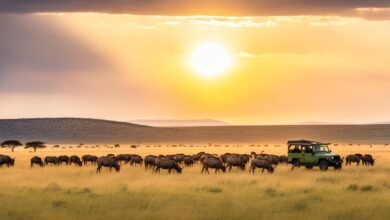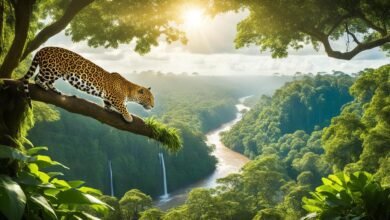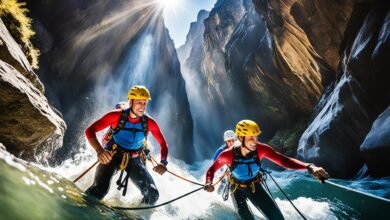Table of Contents
The Inca Trail to Machu Picchu is a famous hiking route. It was built by the Inca Empire in the 15th century. This path takes you to the ancient Machu Picchu ruins. By walking the Inca Trail, you can enjoy the beautiful Andean landscapes. You also get to learn about the Inca’s rich history and culture. The trail includes rainforests, forests in the clouds, and tough mountain climbs.
To start this journey, you need to plan ahead. You should work with a registered tour operator to get the necessary entry permits. The Peruvian government does this to protect the area. Good planning and being ready is key to having a great time on the Inca Trail. So, what steps do you need to take to plan your Machu Picchu adventure on this ancient path?
Understanding the Inca Trail to Machu Picchu
The Inca Trail to Machu Picchu has many options for all kinds of travelers. You can choose from the classic 4-day trek or shorter 2-day trips. There are also 5 to 7-day adventures available.
The Classic 4-Day Inca Trail Trek
The Classic 4-Day Trek is the most chosen route. It leads through beautiful mountains and ancient Inca ruins. It ends at the Sun Gate with a view of Machu Picchu.
Shorter 2-Day Inca Trail Options
Short on time? Try the 2-Day Inca Trail options. They let you see Machu Picchu and its surroundings quickly. You spend one night near Machu Picchu.
Longer 5 to 7-Day Inca Trail Tours
Want a longer adventure? Consider the 5-7 day tours. They take you to more ruins and offer a deeper experience. You’ll learn a lot about Inca history and enjoy the Andean landscapes.
To trek the Inca Trail, always go with a licensed operator. They will get the permits needed for your trip.
Inca Trail Permit Requirements
Trekking the Inca Trail to Machu Picchu is tightly regulated. The government of Peru limits the number of hikers each day. Hikers must get an Inca Trail permit through a licensed tour operator. These permits control the date and group size. They help avoid overcrowding and protect the trail.
Tour companies help you get the permits. They make sure all needed documents and fees are right. Since permits for busy times can run out early, it’s smart to book your trek in advance. Using a good tour company makes getting a permit easier. It also makes sure you can enjoy this special hike.
| Inca Trail Permit Requirements | Details |
|---|---|
| Permit Issuance | Can only be obtained through licensed tour operators |
| Permit Limits | Strict daily cap on the number of trekkers allowed on the Inca Trail |
| Permit Information | Specifies trek date, group size, and other essential details |
| Permit Importance | Crucial for managing overcrowding and preserving the ancient trail |
| Booking Timeline | Popular trekking months sell out months in advance, so early planning is essential |
Getting your Inca Trail permit through a licensed tour operator makes everything smoother. Remember, early planning and booking are vital for this amazing journey.
Choosing a Licensed Inca Trail Tour Operator
When hiking the Inca Trail, always book with a licensed operator. They handle the permits needed. Picking a known local company has great benefits. Reputable local Peruvian firms know the trail well. They have strong bonds with porters and other helpers. They’re also big on eco-friendly tourism that helps the area.
Benefits of Using a Local Peruvian Company
Going with a local firm means you get top-notch service. They know the trail’s history and its importance. This makes your trek more than just a walk; it’s a learning adventure. Plus, their contacts with the local workers keep everything running smoothly.
Services and Amenities Provided
Your Inca Trail experience will be top of the line, thanks to these operators. They cover everything from travel to trailhead to cozy camp setups. Meals are gourmet, made by talented chefs. Guides filled with info on the Incas will lead the way. You might even get neat extras like satellite phones or help with your gear.
Preparing for the Inca Trail Trek
Trekking the Inca Trail to Machu Picchu is a big deal. You need to get in shape and have the right stuff. The trail goes up a lot and takes long to finish, so get ready by working out and lifting some weights. It’s also key to buy good hiking boots, clothes you can layer, and everything else you need well in advance.
Physical Training and Gear
Getting ready for the Inca Trail means getting fit and staying that way for months. Do things like walking, riding a bike, or climbing stairs to get your heart pumping. Don’t forget to lift weights to help with your stamina and power. And, don’t let your hiking boots be new; wear them in first.
It’s not just about the boots. You’ll need clothes that keep you dry, warm, and safe from the weather out there. Pack a strong backpack, some water bottles, poles for hiking, and all your personal care items. These things will keep you comfy on the trail.
Acclimatizing to High Altitudes
Adjusting to the high places on the Inca Trail is a must for your health. Places get over 13,000 feet above sea level. Stay in Cusco or the Sacred Valley a few days before your hike to get used to the thin air. This will help prevent you from getting sick.
If you start feeling bad from altitude sickness, like headaches or tiredness, try to drink lots of water, eat well, and rest. Your guide knows how to help with this. They can give you tips to deal with the high altitude safely, so you enjoy your journey.
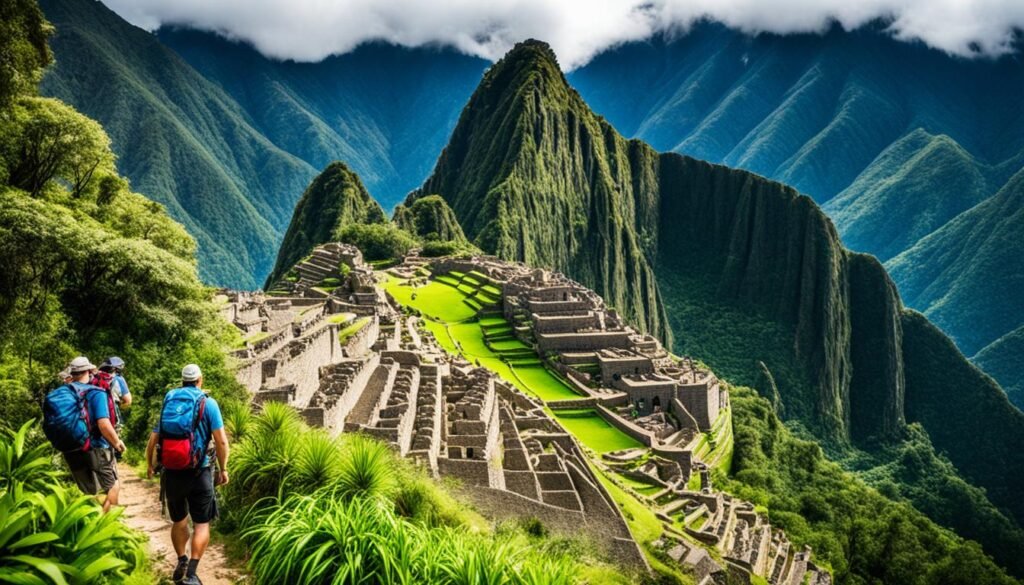
How can I arrange a trek to Machu Picchu along the Inca Trail?
To arrange a trek to Machu Picchu through the Inca Trail, you need a licensed tour operator. They will help with getting the permits needed for your journey. You’ll have to fill in traveler details, pay a deposit, and let the operator handle the permit process with the government.
Booking Process and Timelines
Getting Inca Trail permits can be tough since they’re limited and sell out quickly. It’s best to start planning and booking your trek early, several months before your trip.
Required Documentation
You need to have your passport information ready for your trek booking. Often, you’ll need to show your original passport at checkpoints along the trail. Having the right documents ensures your trek goes smoothly.
Day-by-Day Inca Trail Itinerary
The classic 4-day Inca Trail trek follows a well-established itinerary. It leads hikers through stunning Andean landscapes and past ancient Inca ruins. This journey shows the rich history and culture of the Incas, ending at the breathtaking Machu Picchu citadel.
Day 1: Cusco to First Campsite
In the morning, trekkers leave Cusco and head to the trailhead. This is where their hike toward the first campsite starts. This day begins the adventure, with hikers seeing the beautiful countryside and the Andes for the first time.
Day 2: Dead Woman’s Pass Challenge
The second day is the toughest part of the trek. Hikers climb to Dead Woman’s Pass, which is over 13,800 feet high. This challenging journey rewards them with amazing views after the climb.
Day 3: Approaching Machu Picchu
On the third day, hikers go down through lush cloud forests. They get to explore Inca sites on the way. The excitement to see Machu Picchu the next day starts to grow.
Day 4: Arrival at Machu Picchu
The fourth day brings trekkers to the Sun Gate, facing the Machu Picchu ruins. Seeing this site after days of hiking is incredibly rewarding. They then explore the Inca citadel and its amazing history and architecture.
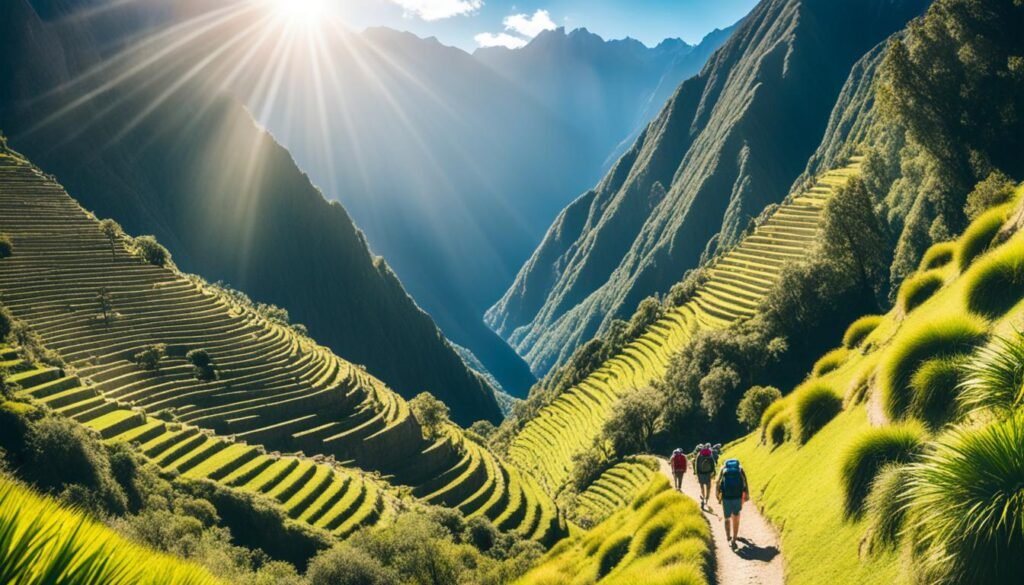
Highlights Along the Inca Trail
The Inca Trail trek offers more than just a sense of achievement. It shows breathtaking scenery and the Inca civilization. Trekkers will see Inca ruins and archeological sites, learning about the Inca Empire’s advanced engineering.
Ancient Inca Ruins and Archeological Sites
Key Inca ruins and sites include Llactapata and Wiñay Wayna. They show the Inca people’s skill. They built detailed stone buildings, roads, and farming systems in the Andes.
Stunning Mountain Vistas
Hikers see stunning views on the Inca Trail. There are snow-capped Andean peaks and lush forests. This journey through Peru’s nature is unforgettable for anyone.
Diverse Ecosystems and Wildlife
The trail crosses various environments, from high mountains to cloud forests. Trekkers might spot condors and colorful birds. The rich plant and animal life make the trek truly immersive.
Best Time to Hike the Inca Trail
The Inca Trail can be hiked any time of year. However, certain seasons provide better conditions. Knowing the benefits of each season helps you choose the best time for your journey to Machu Picchu.
Dry Season Considerations
The dry season runs from April to October. It’s the ideal time for the Inca Trail trek. You’ll enjoy drier, warmer weather with fewer clouds. This season gives you amazing views of the Andes.
But, this time is also the busiest. Tourist numbers increase, making the trails more crowded. And getting one of the limited Inca Trail permits can be harder.
Rainy Season Considerations
From November to March is the rainy season. It brings lush, green landscapes but also more rain. The trails may get muddy, and there’s a chance they’ll close in February for maintenance.
On the bright side, you’ll see the Andes at their greenest. This season offers a unique view of the scenery. Just be ready for frequent rain and overcast skies.
Your decision on the best time to hike the Inca Trail depends on your priorities. It also depends on how you handle different weather and trail conditions. Thinking about these aspects will make sure your Andean trek is fantastic. And exploring the Inca ruins will be a memorable experience.
Extending Your Stay at Machu Picchu
After the Inca Trail trek, many visitors love to stay longer at the iconic Machu Picchu. They want to explore the ancient citadel more. There are many things to do, like climbing Huayna Picchu or Machu Picchu Mountain for amazing views.
Visitors also enjoy seeing the Inca Bridge or checking out the town of Aguas Calientes. It’s at the base of Machu Picchu. Some people choose to spend an extra night in Aguas Calientes. This gives them more time to experience the wonder of Machu Picchu before heading back to Cusco.
It’s really important to plan well and talk to your tour operator for these longer stays. This can help make your extended time at Machu Picchu smooth and enjoyable.
| Additional Machu Picchu Attractions | Duration | Difficulty Level |
|---|---|---|
| Climbing Huayna Picchu | 2-3 hours | Challenging |
| Climbing Machu Picchu Mountain | 2-3 hours | Moderate |
| Visiting the Inca Bridge | 1-2 hours | Easy |
| Exploring Aguas Calientes | Half day | Easy |
Talking with your tour operator is key to enjoying a longer stay at Machu Picchu.
Tips for a Successful Inca Trail Adventure
To make your Inca Trail trek to Machu Picchu memorable, prepare well and respect the local culture. This will help ensure your journey is a success. Make sure you’re ready for an adventure that respects the history of the area.
Packing Essentials
It’s key to pack the right gear for comfort and safety on the Inca Trail. A good pair of hiking boots is a must, with strong soles and solid ankle support. The weather can change, so layer your clothes with materials that wick away sweat. Include rain and sun protection in your gear. Don’t forget a water bottle, snacks, a headlamp, and any medication you may need.
Dealing with Altitude Sickness
The high altitudes on the Inca Trail, reaching over 13,000 feet, are tough. Spending a few days in Cusco or the Sacred Valley beforehand can help you get used to it. Remember to drink plenty of water, go at your own pace, and watch for signs of altitude sickness, like headaches or feeling tired. Your tour guide will know how to help if you start feeling sick.
Respecting Cultural Heritage
Walking the ancient Inca Trail means you’re in a place of historic and natural importance. Be sure to follow the Leave No Trace rule: stay on the trail, properly dispose of trash, and be careful not to harm the sites or bother locals. Respect the area and its past by acting thoughtfully and with gratitude.
Alternative Treks to Machu Picchu
The Inca Trail is amazing, but there are other great ways to get to Machu Picchu. The Salkantay Trek is one. It goes through the beautiful Salkantay mountain range before meeting the Inca Trail. This makes for a unique and tough adventure.
Another good choice is the Lares Trek. It shows off traditional Andean villages and stunning mountain views. These treks are perfect for people who love hiking and exploring new places.
If you’re short on time or don’t want to walk for days, no worries. You can take a train or bus to Machu Picchu. It’s a different experience but still magical. This way, you can see the wonders of Machu Picchu without a long hike.
Choosing the right trek depends on what you like, how fit you are, and how much time you have. Whether you go for the classic Inca Trail or another path, it’s a memorable journey. Do some research to find what’s best for you. Machu Picchu is waiting to be explored!
